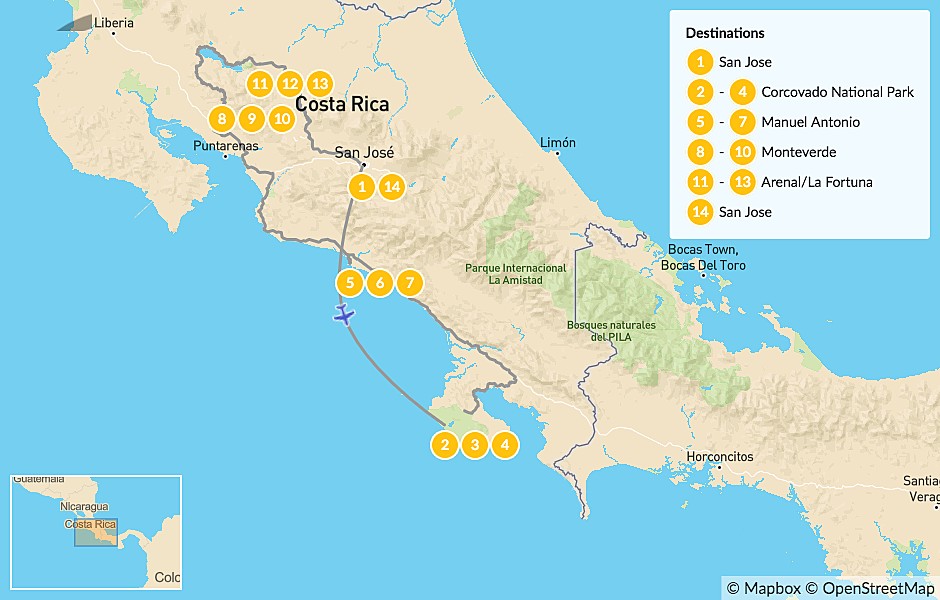Highlights
- Explore the Osa Peninsula, including the biologically diverse Corcovado National Park
- Scuba dive in the protected marine reserve of Isla del Caño
- Zip-line over the rainforest canopy in the Monteverde Cloud Forest Reserve
- Brave the rapids on a whitewater rafting trip near the famous Arenal Volcano
- Take a dip in La Fortuna Waterfall—the most famous falls in the country
Brief Itinerary
| Day | Highlights | Overnight |
|---|---|---|
| Day 1 | Arrive in Costa Rica - Experience San José's Culture and History | San Jose |
| Day 2 | Fly to Osa Peninsula - Explore Bahía Drake | Corcovado National Park |
| Day 3 | Corcovado National Park Hike | Corcovado National Park |
| Day 4 | Snorkeling & Scuba Diving at Isla del Caño | Corcovado National Park |
| Day 5 | Osa Peninsula -> Drive to Manuel Antonio National Park | Manuel Antonio |
| Day 6 | Guided Hike of Manuel Antonio National Park | Manuel Antonio |
| Day 7 | Free Day in Manuel Antonio | Manuel Antonio |
| Day 8 | Manuel Antonio -> Drive to Monteverde | Monteverde |
| Day 9 | Monteverde Cloud Forest Reserve Guided Hike | Monteverde |
| Day 10 | Aerial Fun in the Cloud Forest | Monteverde |
| Day 11 | Drive to Arenal Volcano - Hot Springs | Arenal/La Fortuna |
| Day 12 | Whitewater Adventures at Arenal | Arenal/La Fortuna |
| Day 13 | La Fortuna Waterfall - Free Afternoon | Arenal/La Fortuna |
| Day 14 | La Fortuna - Drive back to San José | San Jose |
| Day 15 | Depart San José |
Detailed Itinerary
Day 1: Arrive in Costa Rica - Experience San José's Culture and History

Welcome to Costa Rica, the land of pura vida! After arriving at Juan Santamaría International Airport in San José, a local representative will meet you and escort you to your hotel. The rest of the day you'll have free to explore the city at your leisure.
Perhaps take a stroll through Mercado Central (Central Market), featuring over 200 shops, food stalls, and sodas (traditional restaurants). Then visit the Catedral Metropolitana (Metropolitan Church), whose interior combines Greek Orthodox, Neoclassical, and Baroque styles, and features wood carvings and stained-glass windows. There's also a pair of popular museums in San José: Museo del Oro Precolumbino (Pre-Columbian Gold Museum), and Museo del Jade—the world's largest collection of pre-Columbian jade artifacts.
Be sure to explore Barrio Amón, a historic neighborhood home to cafetalero (coffee grower) mansions built during the late 19th and early 20th centuries. Many of this area’s historic buildings have been converted into hotels, restaurants, and galleries, making Amón a popular bohemian district.
For dinner, opt for a restaurant in the hills of Escazú. This elevated region on the western edge of the city offers panoramic views of the valley below. That said, San José is filled with great restaurants serving everything from traditional to forward-thinking fusion cuisine.
Day 2: Fly to Osa Peninsula - Explore Bahía Drake

In the morning you'll board a flight to Bahía Drake (Drake Bay), one of the main villages on the secluded Osa Peninsula. This peninsula is located on the southern Pacific coast and is one of the least developed regions in Costa Rica. It's also the gateway to the famed Corcovado National Park, located directly south of Drake. This famous protected area is known for its virgin rainforests and wind-swept beaches, which are all the more evocative due to the relative lack of crowds.
Upon arrival to Bahía Drake, check into your hotel. You'll now have the entire day to relax and enjoy the beaches until your heart's content. At night, tuck into dinner at your lodgings. Drake's remoteness and limited restaurant options mean most accommodations offer all-inclusive meals.
Alternative airport: Puerto Jiménez
Day 3: Corcovado National Park Hike

This day trip into the rainforest is a chance to explore Parque Nacional Corcovado, home to species including the endangered giant anteater, harpy eagle, tapir, and jungle cats like the jaguar, puma, and margay. From the hotel, it's a 25-minute boat ride south down the coast of the Osa Peninsula. After the wet landing (boats go in stern first and drop you a few feet from the beach) near the San Pedrillo ranger station, you’ll begin the rainforest journey.
During the hike, your bilingual naturalistic guide will point out wildlife along the trail. You may see capuchin, spider, and howler monkeys, as well as white-lipped peccaries, scarlet macaws, coatis, and countless other birds and insects. The trails are clearly marked and easy to navigate, ascending and descending through the rainforest.
After the morning hike and a break for lunch, you'll enjoy more wildlife sightings as you trek to a cascading waterfall. There will be time to relax and swim in the natural pools before you return to the ranger station and catch the boat back to your hotel. While on the water, be on the lookout for humpback whales or dolphins breaching the ocean's surface.
Day 4: Snorkeling & Scuba Diving at Isla del Caño

Today, you'll explore the waters of the Caño Island Biological Reserve on a scuba excursion. This protected marine area is located just off the northern tip of the Osa Peninsula, next to Bahía Drake. It's home to an abundance of marine life including reef sharks, sea turtles, parrot fish, eels, manta rays, puffer fish, snappers, sea cucumbers, octopus, and many more. There's also a wide variety of coral-building organisms and 19 different species of coral.
Board a 30-foot Island Hopper and an expert will offer a safety lesson geared for all ages and experience levels. Then it's time to plunge into the water. Visibility is 30-100 feet throughout the year, making Caño Island a perfect site for underwater photography. Not interested in diving? Snorkeling gear will be available as well.
Day 5: Osa Peninsula -> Drive to Manuel Antonio National Park

After breakfast, it's time to continue your trip—now with you behind the wheel. In the morning you'll transfer by boat to the village of Sierpe and pick up a rental car. Then take the coastal road north to Manuel Antonio National Park. The drive is around 2 hours, but along the way you'll have time to stop at a number of small coastal towns.
One such town is Sierpe. This area (located at the junction of the Terraba and Sierpe rivers) is home to the Terraba Sierpe National Wetlands, Latin America's largest mangrove reserve. Boat tours traverse the network of waterways in these mangrove forests, and guides point out all manner of exotic creatures, from monkeys and caimans to waterbirds like herons and kingfishers.
After driving about an hour north, you'll pass through Uvita and Dominical. There are a handful of coves and bays around these little villages, many featuring white-sand beaches, and turquoise waters. If you have time, stop and explore the Marino Ballena National Park, which is also located in the Uvita area. It was named because of the humpback whales that migrate just offshore—get lucky and you might spot one or two.
You can spend the afternoon making pit stops along the coast at your leisure. When you do finally arrive in Manuel Antonio, check into your hotel and spend the rest of the afternoon and evening relaxing.
- Gabriella's, treat yourself to some fine dining at this local institution. Go for the seafood—whether it's the pan-seared scallops, ceviche, or snapper, you won't be disappointed. The steaks are nothing to sneeze at, either.
- Cafe Agua Azul, come during sunset because the second-floor patio dining here might offer the best bay views in the entire area. Agua Azul excels at fresh fish and delectable desserts like homemade brownies and bread pudding.
- Manuel Antonio Falafel Bar, for something different head to this casual middle-eastern joint. It offers great falafel, shawarma, hummus, and a salad bar any vegetarian would love.
Chat with a local specialist who can help organize your trip.
Day 6: Guided Hike of Manuel Antonio National Park
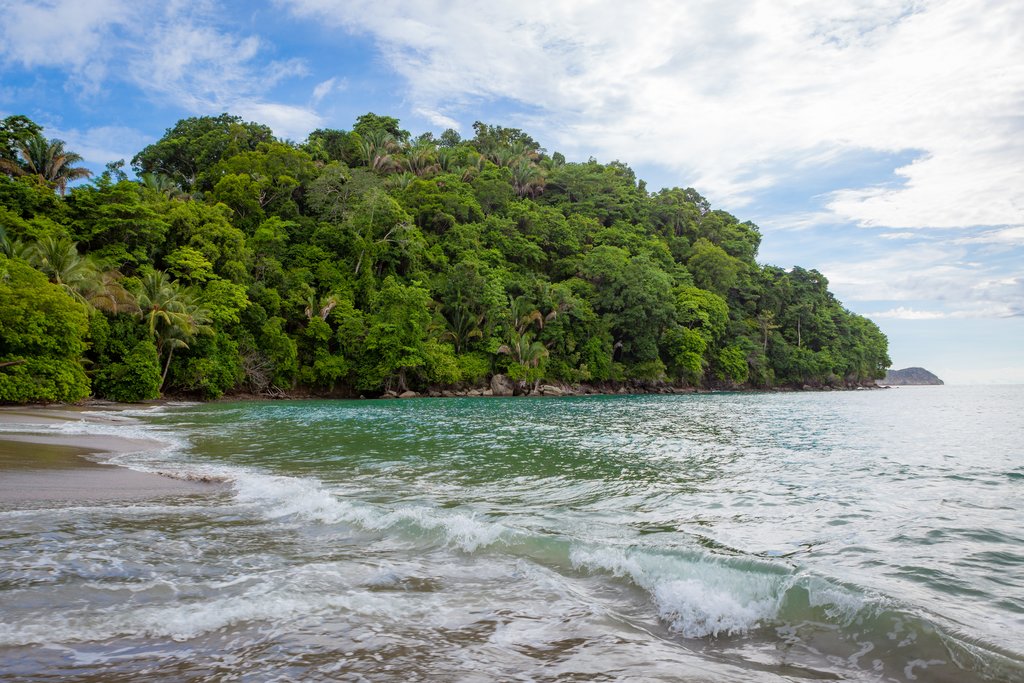
Today you'll wake up early and explore the roughly 1,680 acres (680 hectares) of Manuel Antonio National Park. This is a true gem of Costa Rica, in that the park is home to virgin rainforest running all the way from the mountains down to the coast, where white-sand beaches and coral reefs await.
You'll start your hike on the trails within the park. The walk is easy with mostly flat trails—perfect for families with kids. A naturalist guide will point out the more than 300 species of mammals and birds that call this reserve home, including three-toed sloths, hawks, iguanas, and several different species of monkeys. You'll also have time to enjoy the park's expansive white sand beaches on this half-day tour.
What you do the remainder of the afternoon is up to you! Continue exploring the trails on your own, indulge in the sand and sea, or switch gears and visit the nearby adventure park, MidWorld, for zip-lining and ATV tours.
Hiking distance: 1 mile (1.7 km)
Day 7: Free Day in Manuel Antonio

Today is yours to enjoy unencumbered by schedules. Beyond amazing wildlife hikes, there are a number of activities to choose from.
Consider an optional boat tour to the Damas Island Estuary. This adventure is a Disney Jungle Cruise come to life. Along with a guide, you'll make your way down a network of mangrove canals as white-faced capuchin monkeys swing from branch to branch and exotic birds fly overhead. You might spot caimans or even a crocodile or two.
Another optional add-on is to take a surfing lesson on the beach. If that isn't for you, then simply stake your claim on a section of white sand and relax with a good book. One of the most ideal beaches in the park is Playa Espadilla, which stretches on for nearly a mile and is great for families as it's a tranquil public beach with lifeguards on hand during the day.
Optional Damas Island Estuary Tour: 4 hours (with an English-speaking guide; lunch included)
Day 8: Manuel Antonio -> Drive to Monteverde

Prepare yourself, because after breakfast you're getting back behind the wheel. This time you'll be heading north 3.5 hours from Manuel Antonio to the misty cloud forests of Monteverde, in Guanacaste Province.
At the start, you'll be driving on Costa Rica's famous Gold Coast, alongside the azure waters of the Pacific Ocean. Then, once you enter the Guanacaste highlands, you'll be treated to all that virgin rainforest that produces so much of the nation's biodiversity. Of course, you'll want to make a few stops along the way to appreciate all this untouched natural beauty.
If you're an avid surfer, definitely stop about an hour north of Manuel Antonio, at the village of Jacó. This seaside party town is increasingly popular with wave riders due to its good surf conditions, so feel free to catch a wave or just enjoy a batido (fresh fruit juice) on the beach.
Another interesting stop is right where Route 34 meets the Pacific, near the mouth of the Tárcoles River. This is the location of Crocodile Bridge, a favorite spot of congregating crocodiles. Snap as many photos as you want, just don't get too close.
Eventually, you'll arrive in the Monteverde region. It's famous for its 26,000-acre Cloud Forest Reserve, which is home to countless wildlife species and avian varieties. Suspension bridges throughout the reserve allow for walks above the forest canopy, which affords plenty of opportunities to spot the colorfully plumed resplendent quetzal, a rare and exotic bird. The reserve’s marked trails also pass through exotic fauna and flora, including the greatest number of orchid species on the planet—500—with new ones discovered regularly.
At some point, you'll no doubt want to enjoy a nice dinner. Head to nearby Santa Elena, a charming town with a heavy Quaker influence that’s known for excellent coffee and cheese. Here are a few restaurant suggestions that can be found here:
- Orchid Coffee, serves a menu of smoothies, salads, and sandwiches. Sweet-toothed visitors will appreciate the café’s extensive hot chocolate menu made with authentic Costa Rican cacao and mixed with unique ingredients like cardamom and orange.
- El Jardin Bar & Restaurant, wins visitors over with its tree-top setting, friendly service, and fresh homemade bread served alongside every meal.
- Tree House Restaurant & Café, built around an old higueron (fig) tree, this spot serves well-prepared Costa Rican standards like ceviche and arroz con pollo in a romantic, open-air setting.
Day 9: Monteverde Cloud Forest Reserve Guided Hike
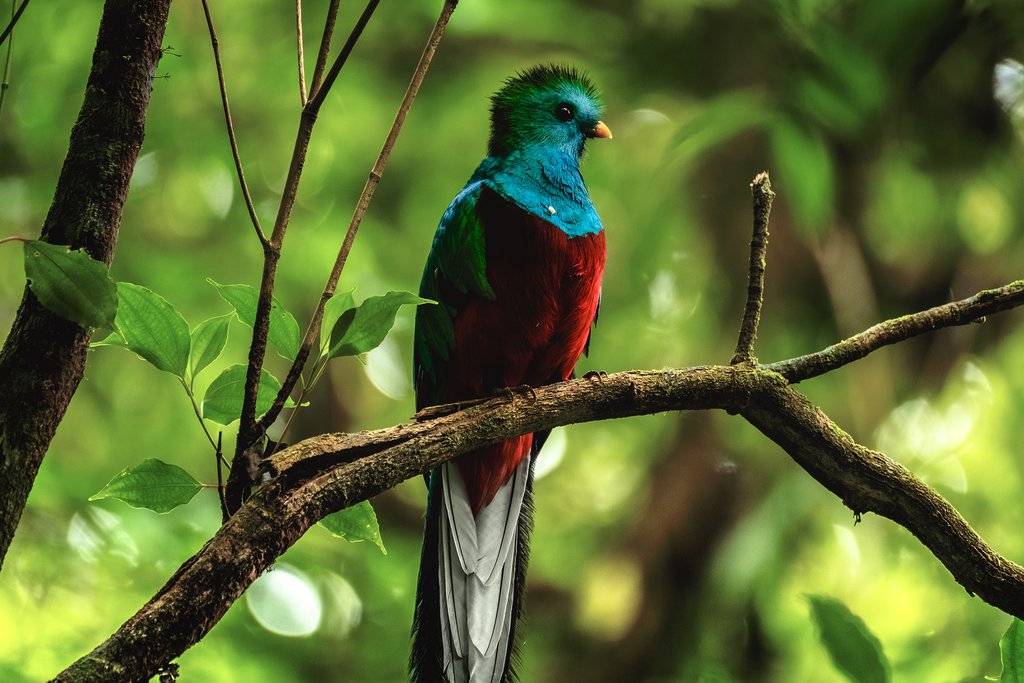
After breakfast, you’ll transfer a short distance to the Monteverde Cloud Forest Reserve, one of the jewels in Costa Rica's ecological crown. Known as the "green lung of Costa Rica" due to its rich biodiversity, this 26,000-acre reserve is located high in the mountainous northwest region of the country. The views of the misty cloud forest here are the stuff of postcards.
But Monteverde offers more than sweeping panoramas. On a guided tour you'll get an up-close look at the incredible biodiversity that occurs in this region, where upland and lowland rainforest meet. More than 350 bird species exist here alone, including the aptly named resplendent quetzal. In other words, it's a nature lover’s paradise.
In the afternoon you'll return to your hotel and have the rest of the day to spend as you like.
Monteverde Cloud Forest hike duration: 3 hours
Day 10: Aerial Fun in the Cloud Forest
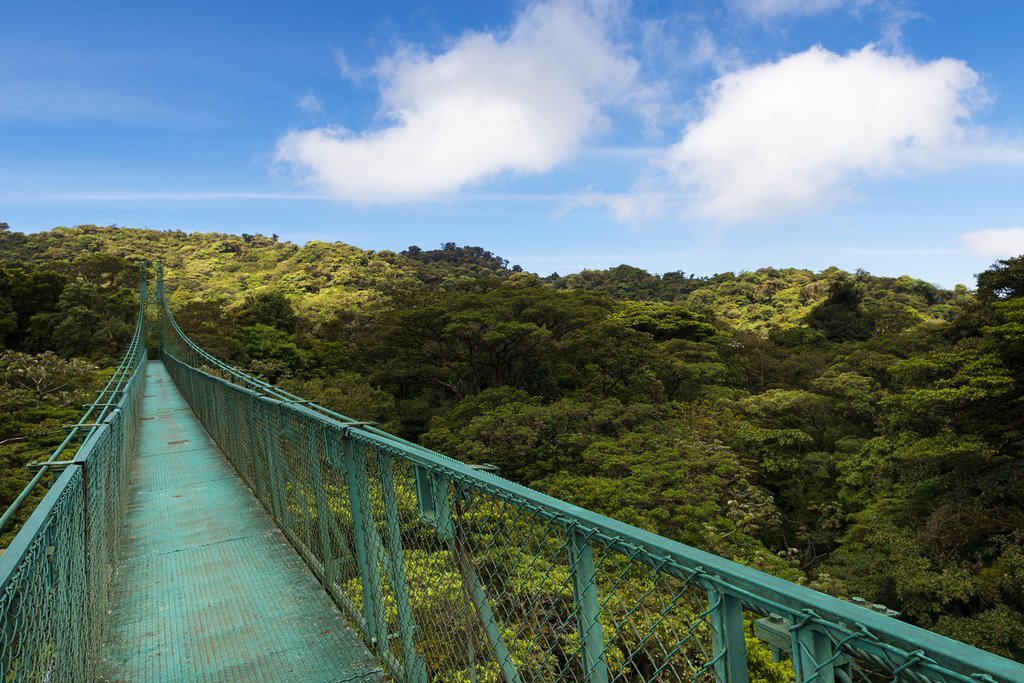
Sky Adventures Monteverde Park is an aerial amusement park that literally raises jungle excitement to the next level. Its Sky Tram network of gondolas transport visitors from one adrenaline pumping activity to another.
First, you'll start with a guided Sky Walk, which combines trails and suspension bridges that ultimately reach heights of up to 984 feet above the jungle canopy. The flora and fauna of the region will be on full display, and our specialized guides will point out the most interesting specimens. Later, you'll ride in an open-air Sky Tram gondola. During this journey, you'll ascend over the rainforest and enjoy sweeping views over the mountains.
Upon reaching the end of the line, the exhilarating adventure of whizzing down the mountain begins. You will connect to a zip-line cable that stretches over the treetops and across canyons, ultimately returning you to the starting point at Sky Adventures' main building. Sky Trek is regarded as the most thrilling zip line in the country—it makes sense, considering that Monteverde is the birthplace of the canopy tour as we know it.
Day 11: Drive to Arenal Volcano - Hot Springs

Today, you'll hit the road again. Travel northeast to the town of La Fortuna, located in Arenal Volcano National Park. Monteverde and Arenal may be close on the map, but this 3.5-hour trip will take you almost the entire way around Lake Arenal.
Naturally, the long drive allows for some great opportunities to stop off and enjoy the countryside. On the southwest side of Lake Arenal, for example, there's the hillside village of Tilaran. This laid-back mountain town is all charm and makes a great place to stop and stretch your legs. Activities include horseback riding over the hills and windsurfing on the lake. There are good birding opportunities here as well, with herons and egrets a common site.
You can also make a short detour to Tenorio National Park, as it's located just north of the lake. This protected area is famously home to the Río Celeste, which some regard as the most beautiful river in the country (it's certainly one of the most popular). The river gets its celestial blue hue from a rare combination of minerals, and there's a fairytale waterfall at the end of a hiking trail.
The hike to the waterfall is 3.7 miles roundtrip. It can be completed in about three hours, so it makes for a good side excursion. That said, the trail can get muddy (especially during the rainy season from May to mid-November), which can slow things down.
For lunch, you can do like the locals and pull off at one of the many roadside sodas. Typical options at these family-run eateries include the casado, a combo plate featuring rice, beans, and your choice of chicken, beef, pork, or fish.
Eventually, you'll arrive in La Fortuna, which sits in the shadow of Volcan Arenal, a 1,633-foot (5,357-foot) volcano. After checking into your hotel, you can enjoy views of the volcano from your balcony or as you relax in a jacuzzi. If you have the energy after your drive, you can also enjoy a zip-line tour over the jungle canopy. For a soothing experience, soak in one of the many naturally heated geothermal pools located at the base of Arenal.
Day 12: Whitewater Adventures at Arenal
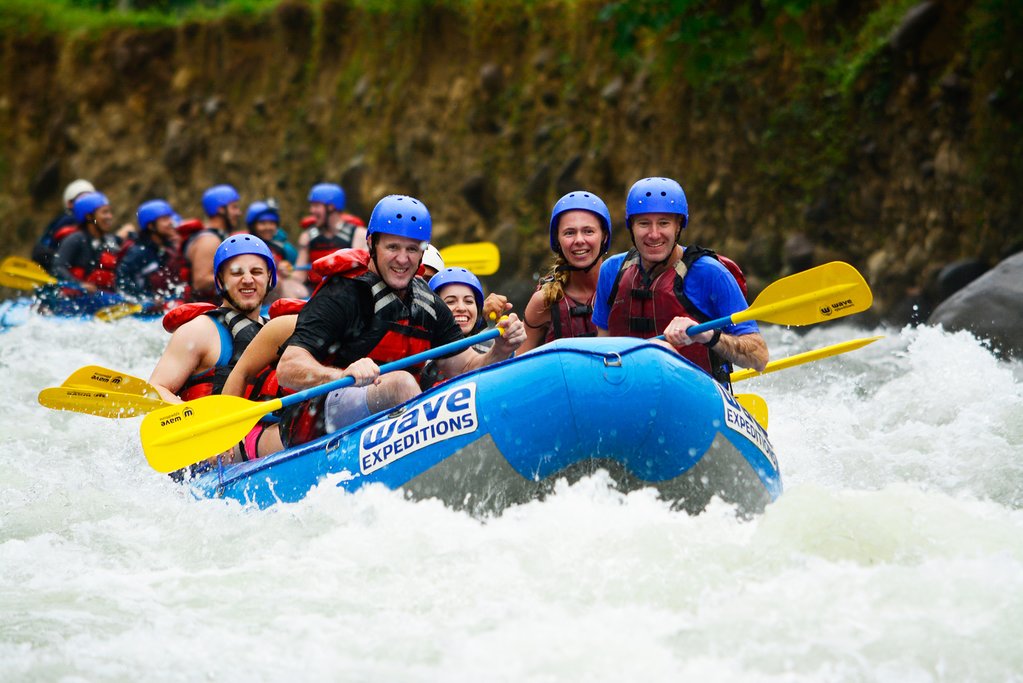
Steel yourself for a morning of whitewater rafting on the Balsa River. After breakfast, your local tour operator will pick you up in the hotel lobby. Be sure to wear clothes you don't mind getting wet, and bring along a spare set of dry ones. Listen to the safety instructions your guide provides during the trip to the raft-launch site, and get set for plenty of rapids.
After the adrenaline rush of your whitewater rafting trip, relax with a traditional Costa Rican lunch on the banks of the river. In the afternoon, you can opt to be dropped off at one of the many hot springs in Arenal to unwind and soothe your muscles in nature's own hydromassage.
Enjoy dinner back in La Fortuna. There are over a hundred restaurants in town, featuring everything from traditional Costa Rican fare to pizza and pasta.
Day 13: La Fortuna Waterfall - Free Afternoon

Today, you'll experience the other star of the Arenal Volcano region: La Fortuna Waterfall. If Arenal is the most famous volcano in the country, then La Fortuna is easily the most famous falls. It's located a 15-minute drive from the town of La Fortuna, at the base of the dormant Chato Volcano. The waters here plunge 210 feet into a tropical lagoon, and a 500-step downhill hike provides the opportunity to see the falls from the bottom up. Besides taking photos, be sure to swim and relax in the La Fortuna River below the falls.
Then it's back to your hotel where you'll spend the rest of the day unwinding. If you want to indulge in the hot springs one more time, no one will blame you.
Day 14: La Fortuna - Drive back to San José

Enjoy your last morning in La Fortuna. Take a stroll around the central plaza, or visit the La Fortuna Waterfall.
If you're interested, you'll have enough time for a chocolate-making tour. In this hands-on program, you’ll learn about the origin, history, and production of one of Costa Rica's most famous exports: chocolate. You'll participate in the cacao harvest, as well as the drying and grinding of the seeds used to produce creamy cocoa butter. Learn how a traditional Costa Rican chocolate drink was developed centuries ago—and, of course, sample freshly made chocolate.
After lunch, it's time to transfer back to San José and drop off your rental car. You'll still have much of the evening to explore the city and take advantage of anything you may have missed at the beginning of the trip.



